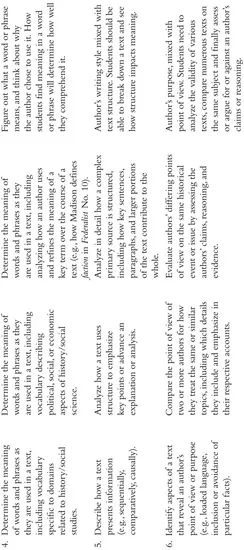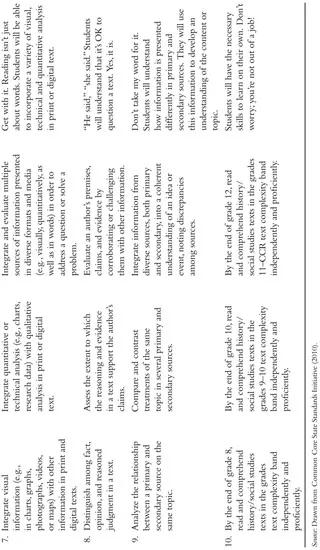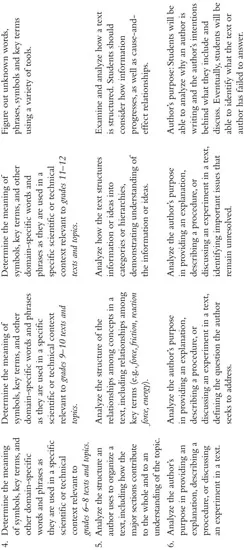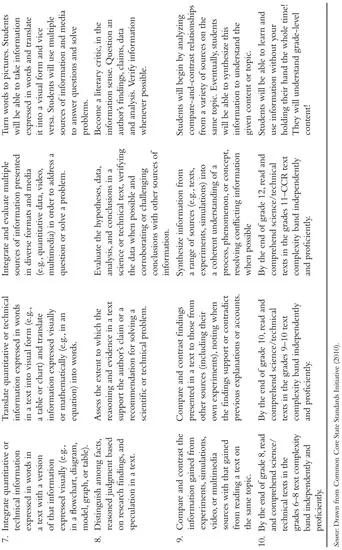![]()
Chapter 1
Introduction
Hating All That’s New
I admit it, I hate trying something new. I’ve had the same favorite restaurant for 15 years, I’ve never had anything but one salad, one dish and one dessert. Why mess with a good thing? I travel to the same vacation spots and shop at the same stores to ensure that I can quickly find frozen edamame or butterscotch syrup. I can only imagine the damage that would come to humankind if I were to venture down the wrong aisle and spend hours futilely searching for whole grain spaghetti noodles or return my cart to the wrong location.
I’m a creature of habit. Routines work for me. That being said, I realize that to be a successful teacher in the 21st century, I must wander into a world unknown or perhaps, in my case, tiptoe. This book is intended to help you tiptoe—or, if you prefer, stomp, jump or skip—into a world that may be slightly new, unknown or at the very least, constantly changing. If you’re like me and hesitant to try something new, the following chapters will show you how to take the wonderful lessons, strategies and activities you’re already using and adapt them to meet the reading and writing demands of the English Language Arts Common Core Standards for History/Social Studies or Science and Technical Subjects, Grades 6–12.
If you’re the type of person (unlike me) who is exhilarated by trying new things, this book is for you too! This book will give you a wide variety of new tools to use in your classroom to help your students become prepared for college and the ever changing workforce of the 21st century. The Common Core Standards don’t just help prepare students for what lies ahead; they give teachers the opportunity we’ve been waiting for to help students explore their interests and prove knowledge by doing more than filling in bubbles.
Be True to You
This book is not intended to make you an English teacher. It is intended to give you the skills you need to ensure that your students are prepared to meet the demands of the Common Core Standards. However, no matter your subject area, you will inevitably be a teacher of English. Another goal of this book is to ensure that reading and writing do not take away from content knowledge but rather apply and prolong it for every student in your classroom.
Although the lessons and activities in this text are directly linked to the Common Core Standards for History/Social Studies and Science and Technical Subjects, Grades 6–12, most of the strategies can be easily adapted to the reading and writing demands in any content area, including Art, Wellness or Physical Education. The activities and strategies provided in this book will focus on engaging students in the learning process that is directly related to reading and writing. Robb (2003) states that “engagement with a text—whether the text is written, oral, or visual—involves that same active, constructive exchange between the known and the new” (p. 23). This text will provide teachers and students with adaptive strategies for the known and introduce new tools that can be used to meet the demands of 21st-century learners, regardless of the content area.
Change as a Process—Baby Steps
This book begins by giving you an understanding of the basic components of the English Language Arts Common Core Standards for History/Social Studies and Science and Technical Subjects, Grades 6–12. Let’s face it: the first step in trying something new is getting to know it and being prepared for the change. That’s exactly what the beginning chapters will help you master. This book will go on to give you examples of how you are already implementing many Common Core Standards in your classrooms. It will hopefully make your lessons more purposeful and, if needed, help you prove to administrators and others that you are preparing students for 21st-century college and career demands. Your lessons will demonstrate higher-level, collaborative, problem-solving students. Each chapter will begin with a short introduction and end with a quick review of what was covered.
The ensuing chapters will go on to help you take what you’re already doing and make it better. I know—it seems unbelievable, right? They will lead you to an understanding that teaching reading is basically teaching our students how to learn and how to think on their own. Good readers do not read without thinking, comprehending and making meaning from text. How many times have you had a student ask you, “Why can’t you just tell me the answer?” Unfortunately, with many answers available to this generation at the drop of a hat, via high-speed Internet, students often do not want to work out or search for an answer. Our job as educators is to make students want to think and discover. We finally get to bring creativity and collaboration back into our classrooms! The purpose of these chapters will be to help you and your students view reading and literacy as a type of learning and thinking and as a way for students to demonstrate their comprehension of content.
The second half of this book gets down to business. These chapters will include lessons, strategies and activities linked to Standards that can be easily implemented or adapted to meet the needs of 21st-century learners. The Common Core Standards emphasize the importance of evidence-based argumentation skills and inquiry-based thinking. These chapters will show you how to incorporate and use a variety of relevant types of texts in your classroom. They give you a strategy, called All A’s for Everyone, that can be used when developing your own lessons by absorbing academic content; analyzing information, text and media; argument; and real-world application.
The closing chapters will focus on how to successfully balance the demands between teaching academic content and literacy, grading and planning. For the record, I strongly believe that, to develop competent college and career-ready students, we need to teach young people to be well-rounded. When I ask my 8th-grade students what they’re interested in on the first day of school, many can’t give me an answer. Of course, they often begin the year thinking that “I don’t know” is an answer. Can they not articulate what they’re interested in, or do they honestly not know? Those who can provide a vague answer, such as sports, video games or shopping, can’t see the connection to who they are as a person or what those interests may mean for their futures. Content area knowledge should be a guide that helps students realize their personal interests and hopefully develop hobbies from them. A student once told me that when she graduated, she wanted to go to nursing school but later told me that she hated science and was planning to take only the necessary classes in high school. She didn’t realize that science and nursing are closely related. How is that possible? Students are going through the motions of school without finding meaning. We need to engage them in meaningful ways that help them develop their interests and see the connections to their future.
The appendixes will offer readers lists of reproducibles and lists of sample activities aligned to the English Language Arts Common Core Standards for History/Social Studies and Science and Technical Subjects, Grades 6–12. I hope these tools will make this book easy to use and guide you toward implementing the Standards into your classroom. Remember: I hate change, but the strategies and activities provided here can be implemented either in full force or in small doses!
Examination of the Main Course
Before we get started, I want to take a minute and really get you to know the English Language Arts Common Core Standards for History/Social Studies and Science and Technical Subjects, Grades 6–12. Let’s begin by examining exactly what the Standards are asking us to do and then analyze how the three grade bands progress from 6th to 12th grade. The best place to start is to look at the fundamentals of each Standard, which I refer to as “the meat,” and then move on to how to apply the multistep higher-level thinking skills to each Standard. Think of this upping of the Standards as adding all the things that make a meal complete—side dishes, seasonings and, of course, dessert!
Why Does This Even Matter?
Now that we know what we’re doing in History/Social Studies, let’s talk about why the progression of skills is important in the Common Core. It is clear to see from Table 1.1 that the English Language Arts Common Core Standards for History/Social Studies Standards, Grade 6–12, build on one another from year to year. It’s significant to note that the higher grade bands are not just incorporating more work or more skills; they’re raising the level of analysis, questioning and thinking skills. Each Standard grows just like a child; it changes in small ways but evolves (with our help) for the better. This is fantastic for teachers because it serves as a ready-made tool to be used for differentiation and student growth. Regardless of the content being covered, we can take a student to a deeper level of learning through analysis and inquiry-based learning and thinking instead of simply moving on in a text or assigning a student more work.
Now let’s take a look at the ELA Common Core Standards for Science and Technical Subjects, Grades 6–12 (see Table 1.2, pp. 8–10).
TABLE 1.1 Common Core Standards for History/Social Studies
TABLE 1.2 Common Core Standards for Science and Technical Subjects
Stepping Outside Your Department, Finding a Different Content Friend
I hope that, regardless of what subject you teach, you take some time to analyze and compare all of the Common Core Standards. You can easily see the similarities between the English Language Arts Common Core Standards for History/Social Studies and for Science and Technical Subjects. The possibilities for collaboration with the Common Core are endless! Remember, change is easier with a friend. Talk to your colleagues about what they’re teaching and how they’re teaching it. Too often, the teachers’ lounge breeds negativity and sob stories. Make it a goal to find someone else ready for a little bit of spice! Collaboration is the key to success, not only for our students but for our teaching. I promise that you can learn at least 10 facts or skills from every teacher in your building. Take advantage of what’s right in front of you. The Common Core Standards are not only content based; they enable teachers to implement a school-wide structure of inquiry-based, higher-level thinking and learning.
So, that was the so-called meat of the English Language Arts Common Core Standards for History/Social Studies and Science and Technical Subjects, Grades 6–12. The following chapters will get to the good stuff—the seasoning, sides and, my favorite, dessert! All of these Standards and their mastery will help your students become self-taught thinkers who are prepared for college and the demands of...






